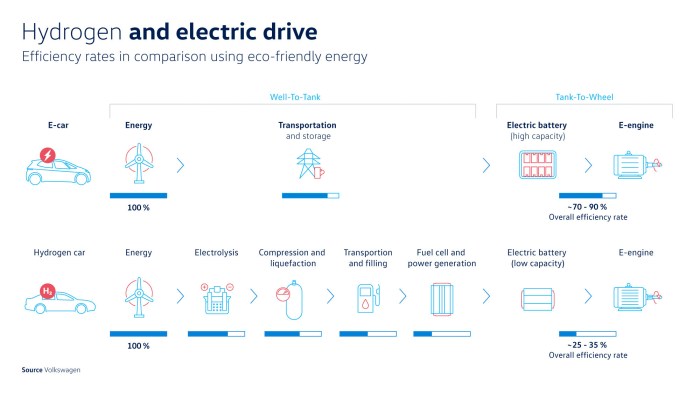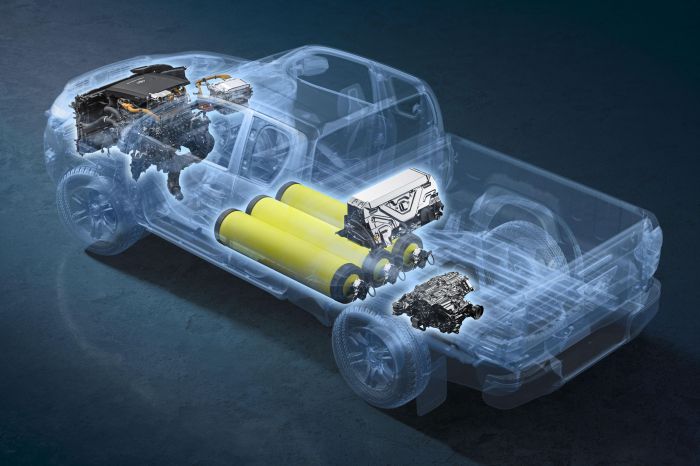Hydrogen fuel cell vs battery EVs 2025: The race to dominate the future of transportation is on! Both technologies promise cleaner driving, but which will emerge victorious in the next few years? We’ll dive into a head-to-head comparison, examining everything from manufacturing processes and environmental impact to infrastructure, cost, and performance. Get ready to explore the key differences and discover which technology might best suit your needs in 2025 and beyond.
This deep dive will explore the technological advancements in both hydrogen fuel cell and battery electric vehicles, comparing their energy density, refueling/recharging times, and overall lifespan. We’ll also analyze the economic and environmental implications of each, including the cost of vehicles, infrastructure needs, and the carbon footprint of production. Finally, we’ll look at how each technology performs in various driving conditions and its potential applications beyond passenger cars.
Technological Comparisons: Hydrogen Fuel Cell Vs Battery EVs 2025

In 2025, both hydrogen fuel cell vehicles (FCVs) and battery electric vehicles (BEVs) represent viable, albeit distinct, approaches to sustainable transportation. Significant advancements in both technologies have reshaped the landscape, presenting consumers and manufacturers with a complex choice. This section will delve into a comparative analysis of their current technological standing.
Technological Advancements in 2025
By 2025, we can expect to see considerable improvements in both FCV and BEV technologies. For BEVs, advancements will likely center on higher energy density batteries, faster charging times, and improved battery management systems leading to extended lifespan and enhanced safety features. Solid-state batteries, for instance, are predicted to be closer to commercial viability, offering increased energy density and potentially faster charging speeds compared to current lithium-ion technology.
On the FCV side, progress will focus on increasing the efficiency of fuel cells themselves, reducing the cost and complexity of hydrogen production and storage, and improving the durability and lifespan of fuel cell components. This includes exploring more robust and cost-effective materials for the fuel cell membrane and catalysts.
Manufacturing Processes and Environmental Impact
The manufacturing processes for both technologies have distinct environmental footprints. BEV battery production is currently energy-intensive, relying heavily on mining and processing of rare earth materials. Furthermore, the disposal and recycling of spent lithium-ion batteries present significant environmental challenges. However, advancements in battery chemistry and recycling technologies are aiming to mitigate these issues. Hydrogen production, on the other hand, presents its own set of challenges.
While electrolysis using renewable energy sources offers a clean pathway, the current energy efficiency of this process is relatively low, and the production of green hydrogen at scale remains a hurdle. Additionally, the energy required for compressing and transporting hydrogen adds to its overall environmental impact. The efficiency and environmental impact of both manufacturing processes are continuously evolving and subject to significant improvement.
Energy Density and Vehicle Range
A key differentiator between FCVs and BEVs lies in their energy density. Hydrogen boasts a significantly higher energy density by weight compared to batteries, meaning that a given mass of hydrogen can store considerably more energy. This translates to a potentially longer range for FCVs, particularly appealing for long-haul transportation. However, batteries offer a higher energy density by volume, leading to more compact battery packs in BEVs.
Therefore, the choice between hydrogen and batteries often depends on the specific application and prioritization of range versus vehicle size and weight. For example, a long-haul trucking fleet might prioritize the range advantage of hydrogen, while a city-based delivery service might opt for the more compact and readily rechargeable BEV option.
Lifespan, Refueling/Recharging, and Maintenance
The following table summarizes a comparison of key operational aspects of FCVs and BEVs in 2025:
| Feature | Battery Electric Vehicle (BEV) | Hydrogen Fuel Cell Vehicle (FCV) |
|---|---|---|
| Lifespan (Years) | 10-15 (Battery lifespan is a significant factor) | 10-15 (Fuel cell lifespan and other components are factors) |
| Refueling/Recharging Time | 30 minutes – several hours (depending on charging infrastructure and battery size) | 3-5 minutes (similar to gasoline refueling) |
| Maintenance Requirements | Relatively low maintenance; battery replacement may be needed after several years. | Higher maintenance requirements; fuel cell components may require periodic replacement or refurbishment. |
Infrastructure and Refueling/Recharging

In 2025, the landscape of transportation fuel infrastructure will be dramatically different depending on whether you’re driving a battery electric vehicle (BEV) or a hydrogen fuel cell electric vehicle (FCEV). While BEVs are experiencing a rapid expansion of charging networks, the hydrogen infrastructure remains significantly underdeveloped, posing a major hurdle for widespread FCEV adoption. This section will delve into the stark contrasts between these two fueling paradigms.The current and projected infrastructure for hydrogen and EV charging in 2025 shows a massive disparity.
So, 2025 is shaping up to be a big year for the Hydrogen fuel cell vs battery EV debate, right? A huge factor in battery EV adoption will be range anxiety, but that’s being tackled head-on with advancements like AI-driven range optimization in electric cars , which learns driving habits to maximize efficiency. Ultimately, these AI improvements could significantly impact the long-term viability of battery EVs versus hydrogen fuel cell vehicles.
Globally, the number of EV charging stations is projected to be in the hundreds of thousands, even millions, depending on the region and level of government investment. This network, while still developing in many areas, is already significantly more extensive than the hydrogen refueling infrastructure. In 2025, the number of hydrogen refueling stations globally will likely remain in the low thousands, concentrated primarily in a few developed nations with active hydrogen initiatives.
This limited availability represents a significant barrier to FCEV adoption beyond niche markets.
Refueling and Recharging Times and Costs
Refueling a hydrogen vehicle is significantly faster than recharging a battery EV. A hydrogen fill-up typically takes only a few minutes, comparable to a gasoline fill-up. In contrast, even with fast chargers, recharging a BEV can take anywhere from 30 minutes to several hours, depending on the battery size and charging speed. However, the cost of hydrogen fuel is currently substantially higher than electricity for BEVs.
While the price of hydrogen is expected to decrease with increased production, it’s unlikely to reach parity with electricity in the near term. The higher initial cost of hydrogen vehicles also contributes to the overall higher cost of ownership compared to BEVs.
The 2025 EV landscape is shaping up to be a battle between hydrogen fuel cells and battery EVs, with battery tech currently dominating. But a key factor in the overall environmental impact of battery EVs is the production process, like at Tesla’s Gigafactories – check out this article to learn more about how green they really are: How green is Tesla’s Gigafactory production?
. Ultimately, the “greenest” option depends on a lot more than just the car itself.
Environmental Impact of Hydrogen Production and Distribution vs. Electricity Generation
The environmental impact of each fuel source is a complex issue with many factors to consider. A simple comparison isn’t possible without accounting for the source of electricity used for EV charging and the method of hydrogen production.The environmental impact of producing and distributing hydrogen versus generating electricity for EV charging involves a multifaceted comparison. Several factors need consideration:
- Hydrogen Production Method: The most common method, steam methane reforming (SMR), is a carbon-intensive process. However, electrolysis using renewable energy sources offers a cleaner alternative. The carbon footprint of hydrogen drastically changes depending on its source.
- Energy Efficiency: The overall energy efficiency of hydrogen production, storage, transportation, and refueling is lower than that of electricity generation and distribution for BEVs.
- Electricity Source: The environmental impact of EV charging depends heavily on the source of electricity. Charging with renewable energy sources (solar, wind) results in a significantly lower carbon footprint compared to charging with fossil fuel-generated electricity.
- Transportation and Distribution: Transporting and distributing hydrogen requires specialized infrastructure and often involves energy losses, adding to its environmental impact.
- Lifecycle Emissions: A full lifecycle assessment, considering the entire production chain from raw materials to vehicle end-of-life, is crucial for a comprehensive comparison.
Geographical Distribution of Infrastructure
Imagine a world map. For EV charging stations, you’d see a relatively dense network in major cities and along major highways of developed countries, with sparser coverage in rural areas and developing nations. The density would be higher in regions with strong government incentives and public awareness. In contrast, the map for hydrogen refueling stations would show a very sparse distribution, with clusters concentrated around specific pilot projects and industrial areas, predominantly in a few select countries like Japan, Germany, and South Korea.
Large swaths of the map would be completely blank, reflecting the limited global adoption of hydrogen infrastructure. The contrast between the two maps vividly illustrates the substantial gap in infrastructure development.
Economic and Environmental Factors

In 2025, the economic and environmental landscape for both hydrogen fuel cell vehicles (HFCVs) and battery electric vehicles (BEVs) will be a key determinant of market share. While BEVs currently hold a significant advantage in terms of established infrastructure and lower upfront costs, HFCVs promise longer ranges and faster refueling times, potentially appealing to specific consumer segments. However, the overall cost-effectiveness and environmental impact of each technology remain subjects of ongoing debate.
Projected Costs of HFCVs and BEVs in 2025
Predicting precise pricing for 2025 is challenging, as technological advancements and market dynamics can significantly impact costs. However, based on current trends, we can anticipate that BEVs will likely remain cheaper to purchase than HFCVs. The higher cost of HFCVs stems from the complexity of the fuel cell system itself, requiring expensive materials like platinum. Operational costs, however, present a more nuanced picture.
While electricity costs for BEVs are generally lower than hydrogen refueling, the price of hydrogen will be a crucial factor. The cost of hydrogen production, influenced by energy sources and production methods, directly impacts refueling costs. If renewable energy sources are predominantly used for hydrogen production, the operational cost gap between BEVs and HFCVs might narrow. For example, a hypothetical mid-range BEV might cost $40,000 to purchase and $500 annually in electricity, while a comparable HFCV might cost $60,000 to purchase but potentially have slightly lower annual fuel costs depending on hydrogen production methods and pricing.
Environmental Impacts of HFCVs and BEVs
The environmental impact of both technologies spans the entire lifecycle, from raw material extraction and manufacturing to vehicle operation and eventual disposal. BEVs generally have a smaller carbon footprint during operation, provided the electricity used for charging comes from renewable sources. However, the manufacturing process of BEVs requires significant energy and resources, including the mining of lithium and cobalt, which can have environmental and social consequences.
HFCVs face a different set of challenges. While their operational emissions are low (primarily water vapor), the production of hydrogen can be highly energy-intensive, particularly with traditional methods like steam methane reforming (SMR). SMR releases significant greenhouse gases, negating some of the environmental benefits. However, using renewable energy sources for electrolysis to produce “green” hydrogen drastically reduces the carbon footprint.
Battery recycling is also a significant environmental concern, and technological advancements are needed to make this process more efficient and environmentally friendly.
Government Policies and Subsidies
Government policies and subsidies play a crucial role in shaping the market adoption of both HFCVs and BEVs. Tax credits, purchase incentives, and infrastructure investments can significantly influence consumer choices. In 2025, we can expect continued government support for BEVs, given their current market dominance and established supply chains. However, governments may also start to invest more heavily in hydrogen infrastructure and incentivize the production of green hydrogen to support HFCV adoption, especially in sectors requiring long ranges and fast refueling, such as heavy-duty trucking.
The level of government support will depend on national energy policies, environmental targets, and economic priorities. For example, countries with ambitious renewable energy targets might prioritize subsidies for green hydrogen production, while others might focus on supporting the electrification of the transportation sector.
Comparative Analysis of Hydrogen Production Carbon Footprints
The carbon footprint of hydrogen production varies significantly depending on the method used. The following table summarizes the approximate carbon emissions associated with different production methods. Note that these figures are estimates and can vary depending on factors such as energy source efficiency and geographic location.
| Hydrogen Production Method | Primary Energy Source | Approximate CO2 Emissions (kg CO2e/kg H2) | Remarks |
|---|---|---|---|
| Steam Methane Reforming (SMR) | Natural Gas | 8-12 | Significant greenhouse gas emissions. |
| Electrolysis with Renewable Energy | Solar, Wind, Hydro | <1 | “Green” hydrogen; very low emissions. |
| Electrolysis with Fossil Fuels | Coal, Natural Gas | 5-10 | Lower emissions than SMR but still significant. |
| Gasification of Biomass | Biomass | 2-5 | Carbon-neutral if sustainably sourced biomass is used. |
Vehicle Performance and Applications
The choice between hydrogen fuel cell vehicles (FCVs) and battery electric vehicles (BEVs) often hinges on performance characteristics and suitability for various applications. While both offer zero-tailpipe emissions, their performance profiles and ideal use cases differ significantly, impacting their overall viability in the 2025 market and beyond.
Understanding these differences is crucial for consumers, policymakers, and industry stakeholders alike. This section will delve into the performance characteristics of both technologies, exploring their suitability for different vehicle types and applications, and highlighting their strengths and weaknesses in diverse driving scenarios.
Performance Characteristics Comparison
Direct comparisons of acceleration, top speed, and handling reveal subtle but important distinctions between FCVs and BEVs. Generally, BEVs boast quicker acceleration due to the instantaneous torque delivery of electric motors. However, high-performance FCVs are increasingly closing this gap. Top speed is comparable in many models, often limited by factors beyond the powertrain itself (like safety regulations or aerodynamic design).
Handling characteristics are largely dependent on vehicle design and weight distribution, with neither technology inherently possessing a superior advantage.
- Acceleration: BEVs typically exhibit quicker 0-60 mph times than FCVs, although this difference is narrowing with advancements in FCV technology.
- Top Speed: Both BEVs and FCVs can achieve comparable top speeds, usually governed by factors other than the powertrain.
- Handling: Handling characteristics are largely determined by vehicle design and weight distribution, not the powertrain type.
Vehicle Type Suitability, Hydrogen fuel cell vs battery EVs 2025
The optimal technology choice varies greatly depending on the vehicle type. Factors like range requirements, payload capacity, and refueling/recharging infrastructure significantly influence the decision.
- Passenger Cars: BEVs currently dominate the passenger car market due to their established infrastructure, lower initial cost (in many cases), and sufficient range for daily commutes. However, FCVs offer potential advantages for long-distance travel with faster refueling times.
- Heavy-Duty Trucks: Hydrogen fuel cells show greater promise for heavy-duty applications like long-haul trucking and heavy construction equipment. The high energy density of hydrogen allows for greater range and faster refueling, critical for these applications where downtime is costly.
- Buses: Both BEVs and FCVs are viable options for buses, with BEVs potentially better suited for shorter routes and FCVs advantageous for longer routes and faster turnaround times.
Applications Beyond Transportation
Hydrogen fuel cell technology extends beyond transportation, offering significant potential in stationary power generation. This application leverages the clean energy production capabilities of fuel cells to provide reliable power in various settings.
- Stationary Power Generation: Fuel cells can provide backup power for critical infrastructure, remote locations, and even residential applications. They offer a clean and efficient alternative to traditional generators.
- Industrial Applications: Hydrogen fuel cells can power industrial processes requiring clean and reliable energy sources, reducing reliance on fossil fuels.
Driving Conditions and Performance
The performance of both BEVs and FCVs varies under different driving conditions. Cold weather, for instance, significantly impacts battery performance in BEVs, while FCVs may experience slightly reduced efficiency in extreme cold but maintain a more consistent performance.
- Short Trips: BEVs are generally more efficient for short trips due to lower energy losses during startup and operation.
- Long Distances: FCVs potentially offer an advantage for long distances due to faster refueling times, although the availability of hydrogen refueling stations remains a significant limitation.
- Cold Weather: BEV range is significantly reduced in cold weather due to decreased battery efficiency. FCVs experience some efficiency reduction but generally maintain better performance in cold temperatures compared to BEVs.
Future Projections and Market Trends
Predicting the future of any technology is inherently challenging, but analyzing current trends and technological advancements allows us to make informed estimations regarding the market share of hydrogen fuel cell vehicles (HFCVs) and battery electric vehicles (BEVs) in the coming years. While BEVs currently dominate the market, the long-term prospects for both technologies remain a subject of ongoing debate and significant investment.The automotive industry is in a period of rapid transformation, and the relative success of HFCVs and BEVs will depend on a complex interplay of technological advancements, infrastructure development, and consumer preferences.
Several factors, including government policies, energy prices, and breakthroughs in battery and hydrogen technologies, will influence the ultimate market share of each.
Market Share Forecasts
Several market research firms offer varying projections for the market penetration of HFCVs and BEVs. While precise numbers vary, a general consensus suggests that BEVs will maintain a significantly larger market share than HFCVs through 2025 and beyond. For example, some forecasts predict BEVs will hold over 80% of the electric vehicle market by 2025, with HFCVs capturing a niche segment, perhaps in the range of 5-10%, primarily in heavy-duty applications like trucking and buses where their longer range and faster refueling times offer advantages.
Beyond 2025, the market share of HFCVs might see modest growth, but the dominance of BEVs is likely to continue, at least in the passenger vehicle sector, due to their established infrastructure and lower initial cost. These projections, however, are subject to change based on technological advancements and policy shifts. For instance, substantial government subsidies for hydrogen infrastructure could significantly alter the trajectory.
Potential Technological Breakthroughs
Several technological breakthroughs could significantly impact the competitiveness of both technologies. For BEVs, improvements in battery energy density, charging speed, and battery lifespan are crucial. Solid-state batteries, for example, promise higher energy density and improved safety, potentially leading to longer ranges and faster charging times. On the hydrogen side, breakthroughs in hydrogen production using renewable energy sources (green hydrogen) are critical for reducing the carbon footprint of HFCVs.
Advances in hydrogen storage, particularly in terms of reducing the size and weight of tanks, are also needed to enhance the practicality of HFCVs. Furthermore, improvements in fuel cell efficiency and durability are essential to make HFCVs more cost-competitive.
Hydrogen Production and Storage Evolution
The production of green hydrogen, through electrolysis powered by renewable energy, is paramount for the widespread adoption of HFCVs. Current methods often rely on fossil fuels, undermining the environmental benefits. Technological advancements in electrolysis, such as the development of more efficient and cost-effective electrolyzers, are therefore crucial. Similarly, progress in hydrogen storage technologies, moving beyond compressed gas storage to potentially more efficient liquid hydrogen storage or solid-state storage methods, is vital for improving the practicality and range of HFCVs.
One could envision a future where hydrogen is produced locally using solar or wind power and stored efficiently on-site, eliminating transportation costs and environmental concerns associated with long-distance hydrogen transport.
Timeline of Key Milestones (2025-2030)
The following timeline highlights anticipated developments in both technologies:
| Year | Battery Electric Vehicles | Hydrogen Fuel Cell Vehicles |
|---|---|---|
| 2025 | Widespread adoption of improved battery chemistries (e.g., higher energy density NMC cathodes); increased fast-charging infrastructure. | Increased deployment of HFCVs in niche markets (heavy-duty vehicles); continued development of more efficient fuel cells. |
| 2026 | Initial market introduction of solid-state batteries in high-end vehicles; further expansion of charging infrastructure. | Focus on reducing the cost of hydrogen production and improving storage technologies. |
| 2027 | Solid-state battery technology becomes more mainstream; significant improvements in battery lifespan. | Development of more robust and durable fuel cell systems; potential for pilot programs in hydrogen refueling infrastructure expansion. |
| 2028 | Continued improvements in battery technology; increased affordability of BEVs. | Significant advancements in green hydrogen production; increased focus on hydrogen storage optimization. |
| 2029 | Mass market adoption of vehicles with extended range and fast-charging capabilities. | Potential for wider adoption of HFCVs in specific segments, such as long-haul trucking, driven by technological advancements and supportive policies. |
| 2030 | BEVs become the dominant form of electric vehicle; ongoing research into next-generation battery technologies. | Continued development and refinement of hydrogen production, storage, and fuel cell technologies; potential for regional clusters of hydrogen infrastructure. |
Conclusion
So, hydrogen fuel cells or battery electric vehicles? In 2025, the answer isn’t a simple one-size-fits-all. While battery EVs currently hold a significant market advantage due to established infrastructure and lower costs, hydrogen fuel cell technology offers compelling long-term possibilities, especially for heavy-duty vehicles and applications beyond transportation. Ultimately, the winning technology will likely depend on continued technological advancements, government policies, and consumer preferences.
The future of clean transportation is dynamic, and the next few years promise to be pivotal in shaping its trajectory.









